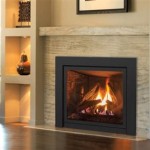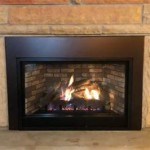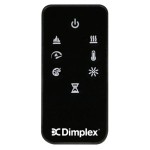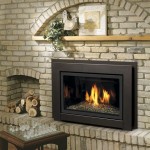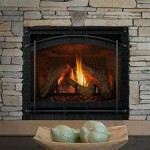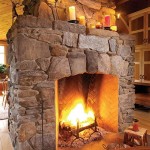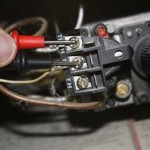Natural Gas Direct Vent Fireplace Insert: A Comprehensive Guide
A natural gas direct vent fireplace insert represents a significant upgrade for homeowners seeking efficient and aesthetically pleasing heating solutions. These inserts are designed to transform existing masonry fireplaces into modern, high-performance heating appliances. Understanding the intricacies of direct vent technology, installation requirements, and performance characteristics is crucial for making an informed decision regarding this type of heating system.
Unlike traditional open-hearth fireplaces, which are notoriously inefficient, direct vent inserts utilize a sealed combustion system. This system draws combustion air from outside the home and vents exhaust gases directly out through a specially designed vent pipe. This process eliminates the need to draw air from the interior of the home, preventing drafts and minimizing heat loss. The direct vent system ensures that combustion byproducts, such as carbon monoxide, are safely vented outdoors, contributing to improved indoor air quality.
The popularity of natural gas direct vent fireplace inserts stems from their combination of convenience, efficiency, and design flexibility. They offer the visual appeal of a traditional fireplace without the labor-intensive process of wood-burning. Natural gas provides a readily available fuel source, eliminating the need for wood storage and reducing the mess associated with ash disposal. Furthermore, these inserts are available in a wide range of styles and finishes, allowing homeowners to seamlessly integrate them into their existing décor.
Understanding Direct Vent Technology
Direct vent technology is the cornerstone of the efficiency and safety of these fireplace inserts. The sealed combustion system is the primary differentiator between direct vent and other types of gas fireplaces. This sealed system operates independently of the home's interior air, which is a critical factor in its efficiency and safety. The system typically utilizes a co-axial or concentric vent pipe, where one pipe draws in fresh air for combustion and the other expels exhaust gases.
The process begins when the insert's burner ignites, fueled by natural gas. A small amount of electricity, typically provided by a standard household outlet or a battery backup, is required to power the ignition system and the control panel. Once ignited, the burner heats the firebox, which is often lined with ceramic logs or decorative glass media to emulate the appearance of a wood-burning fire. The heat generated is then radiated into the room, providing supplemental heating.
The intake and exhaust vents are carefully designed to maintain optimal combustion and prevent backdrafting. The system ensures a constant supply of fresh air for combustion, resulting in a cleaner and more complete burn. This complete combustion minimizes the production of harmful emissions, further contributing to improved indoor air quality. The direct venting system also prevents the loss of heated air from the home, as the insert does not draw air from the interior.
The venting system itself is typically constructed from double-walled, corrosion-resistant metal. The inner wall carries the exhaust gases, while the outer wall provides insulation, preventing condensation and potential damage to surrounding building materials. The vent pipe can be routed horizontally through an exterior wall or vertically through the roof, depending on the fireplace's location and the home's structural layout.
Direct vent systems are designed with safety features such as flame sensors and automatic shut-off mechanisms. These features monitor the flame and gas flow, automatically shutting off the gas supply if a problem is detected, preventing gas leaks or potential hazards. This built-in safety ensures that the fireplace operates safely and reliably.
Installation Requirements and Considerations
Proper installation of a natural gas direct vent fireplace insert is paramount to its safe and efficient operation. Installation should always be performed by a qualified and certified technician who is familiar with local building codes and manufacturer's specifications. Attempting to install the insert without proper training and expertise can result in safety hazards and void the manufacturer's warranty.
The first step in the installation process involves preparing the existing fireplace. This typically includes cleaning the fireplace and chimney, inspecting the chimney for any structural damage, and verifying that the chimney is properly sized for the insert. In some cases, the existing damper may need to be removed or permanently locked in the open position to accommodate the vent pipe.
The vent pipe must be installed according to the manufacturer's instructions, ensuring proper clearances and sealing to prevent leaks. The vent pipe must also be properly supported and protected from the elements. The technician will carefully measure and cut the vent pipe to the required length, ensuring that it fits snugly within the fireplace and extends to the exterior of the home.
Once the vent pipe is installed, the insert is carefully placed into the fireplace opening. The insert must be properly leveled and secured to prevent movement. The technician will then connect the gas line to the insert, ensuring a tight and leak-free connection. A gas leak test is performed to verify the integrity of the connection and prevent any potential gas leaks.
The electrical connection is then made, providing power to the ignition system and control panel. The technician will ensure that the electrical connection is properly grounded and protected from moisture. Finally, the insert is tested to ensure that it is operating correctly. The technician will verify that the burner ignites smoothly, the flame is stable, and the venting system is functioning properly.
Proper ventilation is crucial for the safe and efficient operation of the fireplace. The insert must be installed in an area with adequate ventilation to prevent the buildup of carbon monoxide. Building codes typically specify minimum ventilation requirements for gas appliances, and the technician will ensure that these requirements are met. A carbon monoxide detector should always be installed in the vicinity of the fireplace to provide an early warning of any potential carbon monoxide leaks.
Performance and Efficiency Factors
The performance and efficiency of a natural gas direct vent fireplace insert are key factors to consider when making a purchase. Factors such as heating capacity, energy efficiency ratings, and fuel consumption can vary significantly between different models.
Heating capacity is typically measured in British Thermal Units (BTUs). A higher BTU rating indicates a greater heating capacity, meaning the insert can heat a larger area. The appropriate BTU rating for a particular home will depend on factors such as the size of the room, the insulation levels, and the climate. It is important to select an insert with a BTU rating that is appropriate for the intended heating area to ensure optimal comfort and efficiency.
Energy efficiency is typically measured by the Annual Fuel Utilization Efficiency (AFUE) rating. The AFUE rating represents the percentage of fuel energy that is converted into usable heat. A higher AFUE rating indicates a more efficient appliance, meaning it will require less fuel to produce the same amount of heat. Direct vent fireplace inserts typically have AFUE ratings ranging from 70% to 85%, significantly higher than traditional open-hearth fireplaces.
Fuel consumption is another important factor to consider. The amount of natural gas consumed by the insert will depend on factors such as the BTU rating, the AFUE rating, and the usage patterns. It is important to estimate the potential fuel consumption before purchasing the insert to ensure that it is affordable to operate. Some inserts are equipped with features such as programmable thermostats and remote controls, which can help to optimize fuel consumption and reduce heating costs.
The aesthetic appeal of the insert directly impacts user satisfaction. Modern inserts offer features such as adjustable flame height, realistic log sets, and various decorative options. The ability to customize the appearance of the insert allows homeowners to create a fireplace that complements their existing décor and personal preferences.
Maintenance is crucial for maximizing the performance and lifespan of the insert. Regular maintenance includes cleaning the burner, inspecting the vent pipe, and checking the gas connections. It is also important to schedule a professional inspection at least once a year to ensure that the insert is operating safely and efficiently. Proper maintenance can help to prevent problems such as gas leaks, carbon monoxide buildup, and reduced heating efficiency.

30 Ruby Contemporary Intellifire Touch Direct Vent Fireplace Insert Blower And Remote Electronic Ignition Majestic

Rushmore 30 Direct Vent Fireplace Insert Fine S Gas

White Mountain Hearth By Empire Comfort Systems Direct Vent Gas Fireplace Insert Loft

Majestic Ruby 35 Direct Vent Gas Insert Ruby35 North Country Fire

Direct Vent Gas Fireplace Insert With Intellifire Touch Ignition Syste Wood Majestic

Elevation 36 Direct Vent Fireplace Natural Gas Electronic Ignition

Majestic Trilliant 30 Inch Direct Vent Natural Gas Fireplace Insert

White Mountain Hearth Rushmore Direct Vent Insert With Truflame Tech Fireplaces Usa

Majestic Direct Vent Gas Fireplace Insert Jasper

25 Ruby Traditional Intellifire Touch Direct Vent Fireplace Insert Blower And Remote Electronic Ignition Majestic
Related Posts

